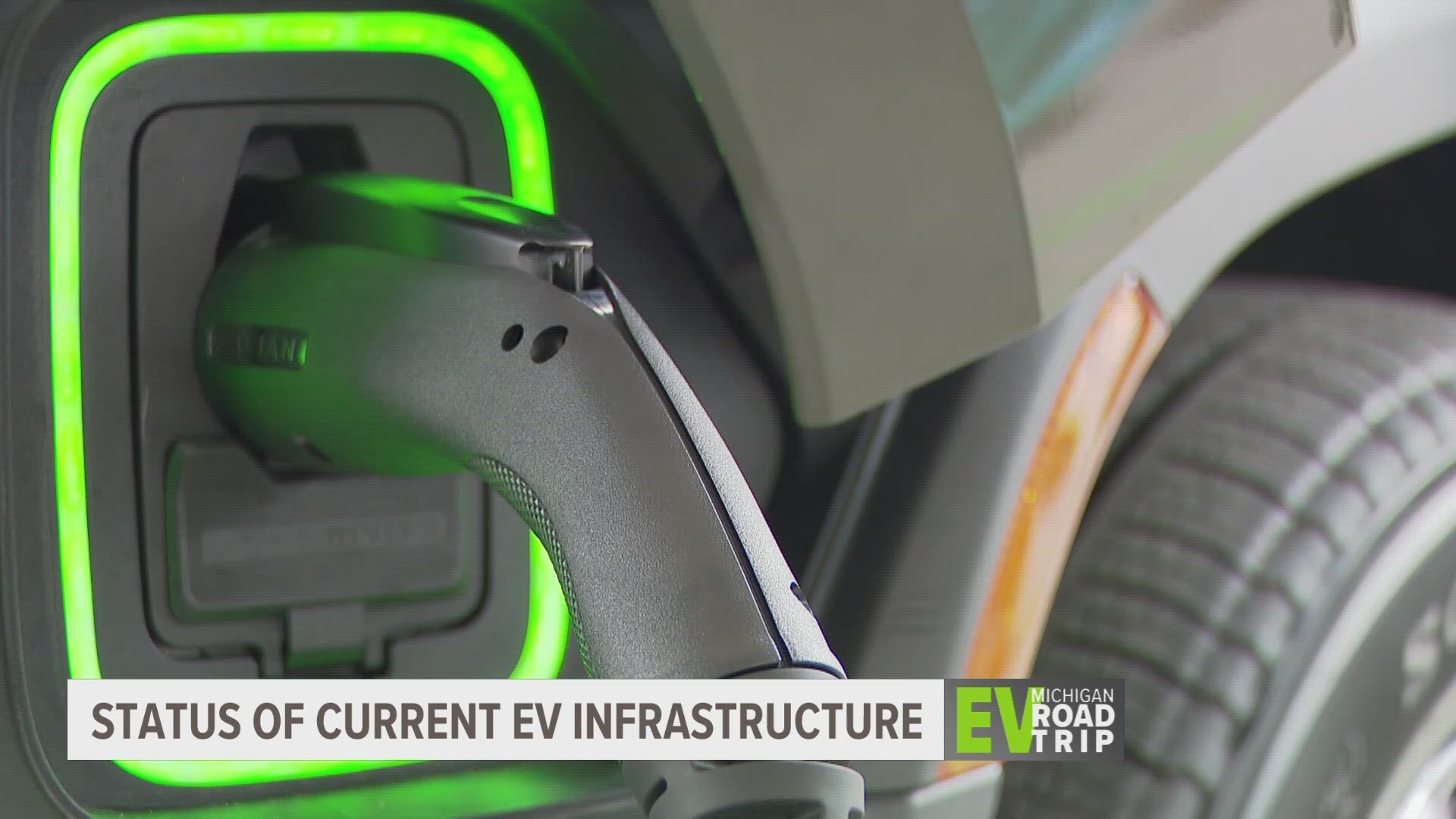MACKINAW CITY, Mich. — It's Day 2 of our EV road trip across the state of Michigan. Today, we're taking a deep dive into infrastructure.
Millions of dollars have been invested in Michigan to update the electric grid so people can use charging stations at home and on the road. Thousands of chargers are being installed across the state of Michigan and many of those chargers are being installed in people's homes. For the most part, they require an upgrade from your current fuse box and the type of at-home charger you get will depend on how much you drive.
"If you only drove to church on Sunday, you could use that outlet, and you could charge your vehicle efficiently. But if you're going to work every day, you would want something a lot bigger than that to charge your vehicle, you would want a level two charger, and it'd be more like plugging in your oven. It does go up from there too," said Joe Ferski from Belasco Electric Company Inc.
The cost of an EV charger depends: The faster you want it to charge, the more it will be. For most, it ranges from $2,000 to $3,500 to get the proper electricity sent to the charger. The charger itself may be free with the car or up to $500. But companies like Consumers Energy have incentives available to cut that cost down. Plus, they say you'll save money overall because it's cheaper to pay for electricity versus paying for gas.
"If you drive maybe 15,000 miles a year, you might be spending with a typical vehicle around $1,500 in gasoline. Now if you switch over to electricity, and you charge off-peak, which is when our lowest time of use rate is that 11 p.m. to 6 a.m. timeframe, that's probably going to drop down to $700," said Jeff Myrom of Consumers Energy.
Consumers Energy has a $120 incentive for those already with EV chargers in their homes, and a $500 rebate for installation. That's through their "PowerMIDrive" initiative. You can find more information about that on their website here.
Organizations like Consumers Energy and DTE are building hundreds of chargers across the state, which is a major component of the EV movement. Millions of dollars are being spent on building accessible charging stations. On a federal level, the Department of Transportation gave Michigan $110 million just for electric vehicle charging alone. And Gov. Gretchen Whitmer’s office has given out more than half a million dollars in grants to organizations creating EV infrastructure.
State leaders and business owners are hoping to put Michigan at the forefront of electric vehicle innovation. And as the state that put the world on wheels, the task isn’t anything new.
Garth Motschenbacher with the Department of Engineering at Michigan State University explains, "You go back to the start of automobiles in general and you know, it was horse and buggy. There were no roads, there were no interstates, there were no gas stations, there was no anything and so when Ford did his thing, and Porsche and Mercedes and Benz, and Toyota, and Billy Chrysler, and Durant, all of those folks that really paved the way for today's automakers did their thing. None of the infrastructure was there, they had to figure out how to cool the engine, and they had to figure out a lot of different things."
But to make those changes and meet the growing EV demand, the electric grid will need updating.
“Our state's aging grid infrastructure, faced with more frequent and severe storm events, requires us to put grid reliability and safety at the top of our list of priorities,” said Terrance Phillips from MEDC.
Innovative companies like "e-CAMION" are overcoming limitations to our electric grid by building Battery Energy Storage Systems. Those systems work independently from the grid and rely on very little power, which makes them ideal for electric vehicles in rural communities.
And Consumers Energy says drivers themselves can help offset the load by charging at night.
"When you're sleeping, pretty much everything is off in your house and so that's the perfect time to charge your electric vehicle. And so, if we start at the home level, and we think about that, and build up, that's where the vast majority of charging happens. And it makes it much easier for the grid to handle the additional load growth from electric vehicles," explained Myrom.
While there are ways to lessen the burden on the electric grid, Consumers Energy and DTE Energy will both need to upgrade their systems to meet future demand.
"We see that this is an energy transition and people will be using more electricity with electric vehicles. But as we look at that adoption, that's going to happen over 10 to 15 years. And that's very easy for us to handle with load growth," said Myrom.
Hope College students are partnering with Ottawa County leaders right now to conduct a road study on electric vehicles. They're in phase two of the process, looking into the limits of Ottawa County's current infrastructure limitations and what they need to change to meet future demand.
►Make it easy to keep up to date with more stories like this. Download the 13 ON YOUR SIDE app now.
Have a news tip? Email news@13onyourside.com, visit our Facebook page or Twitter. Subscribe to our YouTube channel.

